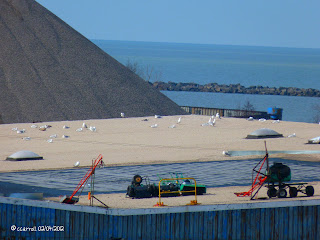... your camera that is.
Many know that American Kestrel is one of my favorite birds. There is something very beautiful about this little falcon.
The back story: On Sunday, February 6th - a completely beautiful, sunny and warm February day in Michigan; the operative word here is sunny - I took my brother's dog and my neighbor's dog for a walk along the Rouge River channel. Before picking up the dogs I argued back and forth with myself, "should I bring my camera or shouldn't I." Finally, I decided not to take it. I would have my bins and both dogs and this would be enough to keep me busy.
I arrived on the channel with the dogs - both completely thrilled to be out - and walked less than half a city block when I saw a beautiful male American Kestrel perched close in a tree. The dogs ran below the kestrel's perch and it did not fly. I don't know what others experience when watching falcons, but my experience is that when encroached upon, they fly pretty quickly. I walked literally under the bird and could see, without the aid of binoculars, the glint in the bird's eye. Still it did not fly.
Remember I had not brought my camera! I continued walking and cursed my decision. I know the rules and still left my camera behind. The dogs were having a blast, and I consoled myself with the thought that there would be another kestrel photo op one day soon.
We walked on, the dogs and I, for another 45 minutes or so. It was such a beautiful day and we were in no hurrry. The Rouge channel walk is an out and back walk. Returning, I had forgotten about the kestrel, but it was there, still in the same tree! It had moved a little but not much. I honestly think it was also enjoying the sun. Still it did not fly when we walked under its perch. Decision time. I hustled the dogs back to car and drove the 1/2 mile home. I ran into the house, grabbed my camera and drove back. I considered taking the dogs but they would only delay me. I left them in the car and walked back up the channel. Remarkably the bird was still on the same perch, the sun was still shining and it would still be a good photo. I took a distant shot and continued to move toward the bird. I took a midway shot and that was it. The kestrel flew across the river to a perch on the other side.
It was not so sunny today, but still a very nice February day for Michigan. Again I had my neighbor's dog. This time I did not leave my camera at home. We did the same walk and I saw two red-tailed hawks soaring. But that was it until I came upon some mallards and canada geese. We walked the same route and on the return, the male kestrel was again perched in the same tree.
The photos I offer here have been cropped and enhanced slightly with a Picasa photo editing program. For example, the sky was not blue and the bird is still pixalated, dark and shadowy.
I don't think of kestrels as birds that would necessarily use the same perch, but perhaps this bird has had some luck hunting from this spot. If it had been a bright sunny day ... but, never mind, at least I had my camera.













